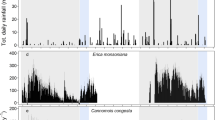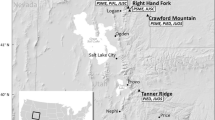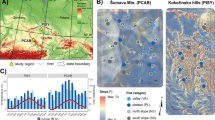Abstract
Increased climatic variability can impact tree physiological processes beyond what is predicted from changes in mean conditions. We assessed the sensitivity of conifer saplings to spatial and temporal variability in meteorological conditions, taking advantage of the end of California’s historic drought and the exceedingly wet winter of 2017. We sought to understand how very dry and very wet conditions constrain photosynthesis and growth in four regionally dominant conifers and whether sensitivity in these processes changes across a 500 m gradient in elevation. All species demonstrated phenotypic plasticity in response to temporal differences in precipitation on both inter-annual and seasonal timescales. Net photosynthesis in Pinus contorta decreased from an early season 2016 average of 12.4 to 6.89 μmol CO2 m−2 s−1 later in the summer, but increased 14.1% between seasons in the wet year. By contrast, elevation had almost no effect on instantaneous photosynthetic gas exchange, CO2 response curve parameters, or stem water potential in any of the years for any of the species. Effects of the heavy snow year (2017) on needle growth differed between elevations. Pinus contorta showed a 38.9% increase in average needle length at the lower two elevations but a 31.6% decrease at the highest site compared to the height of the drought. Despite these differences, biological variation was dampened compared to the physical variation between years, suggesting these trees can effectively withstand substantial meteorological variability. Our results show that these species demonstrated considerable ability to tolerate and recover from an extreme drought event.





Similar content being viewed by others
References
Bales RC, Hopmans JW, O'Geen AT, Meadows M, Hartsough PC, Kirchner P, Hunsaker CT, Beaudette D (2011) Soil moisture response to snowmelt and rainfall in a Sierra Nevada mixed-conifer forest. Vadose Zone J 10:786–799
Berg N, Hall A (2015) Increased interannual precipitation extremes over California under climate change. J Clim 28:6324–6334
Berg N, Hall A (2017) Anthropogenic warming impacts on California snowpack during drought. Geophys Res Lett 44:2511–2518
Buechling A, Martin PH, Canham CD (2017) Climate and competition effects on tree growth in Rocky Mountain forests. J Ecol 105:1636–1647
Carroll CJ, Knapp AK, Martin PH (2017) Dominant tree species of the Colorado Rockies have divergent physiological and morphological responses to warming. For Ecol Manag 402:234–240
Chevin LM, Collins S, Lefèvre F (2013) Phenotypic plasticity and evolutionary demographic responses to climate change: taking theory out to the field. Funct Ecol 27:967–979
Core Team R (2018) R: a language and environment for statistical computing. R Foundation for Statistical Computing, Vienna, Austria https://www.R-project.org/
Das AJ, Stephenson NL, Flint A, Das T, Van Mantgem PJ (2013) Climatic correlates of tree mortality in water-and energy-limited forests. PLoS One 8:e69917
Diffenbaugh NS, Swain DL, Touma D (2015) Anthropogenic warming has increased drought risk in California. Proc Natl Acad Sci 112:3931–3936
Duputié A, Rutschmann A, Ronce O, Chuine I (2015) Phenological plasticity will not help all species adapt to climate change. Glob Chang Biol 21:3062–3073
Duursma RA (2015) Plantecophys - an R package for analysing and modelling leaf gas exchange data. PLoS One 10:e0143346. https://doi.org/10.1371/journal.pone.0143346
Farquhar GD, von Caemmerer SV, Berry JA (1980) A biochemical model of photosynthetic CO 2 assimilation in leaves of C 3 species. Planta 149:78–90
Fotelli MN, Korakaki E, Paparrizos SA, Radoglou K, Awada T, Matzarakis A (2019) Environmental controls on the seasonal variation in gas exchange and water balance in a near-coastal Mediterranean Pinus halepensis forest. Forests 10:313
Griffin D, Anchukaitis KJ (2014) How unusual is the 2012–2014 California drought? Geophys Res Lett 41:9017–9023
Grulke N (2010) Plasticity in physiological traits in conifers: implications for response to climate change in the western US. Environ Pollut 158:2032–2042
Huber NK, Rinehart CD (1965) Geologic map of the devils Postpile quadrangle, Sierra Nevada. California. U.S, Geological Survey https://ngmdb.usgs.gov/Prodesc/proddesc_319.htm
Long S, Bernacchi C (2003) Gas exchange measurements, what can they tell us about the underlying limitations to photosynthesis? Procedures and sources of error. J Exp Bot 54:2393–2401
Pierce DW et al (2013) Probabilistic estimates of future changes in California temperature and precipitation using statistical and dynamical downscaling. Clim Dyn 40:839–856
Pinheiro J, Bates D, DebRoy S, Sarkar D, Core Team R (2018) _nlme: linear and nonlinear mixed effects models_. R package version 3:1–137 https://CRAN.R-project.org/package=nlme
Potts D, Minor R, Braun Z, Barron-Gafford G (2017) Photosynthetic phenological variation may promote coexistence among co-dominant tree species in a Madrean sky island mixed conifer forest. Tree Physiol 37:1229–1238
Rapacciuolo G et al (2014) Beyond a warming fingerprint: individualistic biogeographic responses to heterogeneous climate change in California. Glob Chang Biol 20:2841–2855
Reed CC, Loik ME (2016) Water relations and photosynthesis along an elevation gradient for Artemisia tridentata during an historic drought. Oecologia:1–12
Rinehart CD, Ross DC (1964) Geology and mineral deposits of the Mount Morrison quadrangle, Sierra Nevada. California. U.S, Geological Survey https://ngmdb.usgs.gov/Prodesc/proddesc_447.htm
Stephenson NL, Das AJ (2011) Comment on “Changes in Climatic Water Balance Drive Downhill Shifts in Plant Species’ Optimum Elevations”. Science 334:177
Swain DL, Horton DE, Singh D, Diffenbaugh NS (2016) Trends in atmospheric patterns conducive to seasonal precipitation and temperature extremes in California. Sci Adv 2:e1501344
Swain DL, Langenbrunner B, Neelin JD, Hall A (2018) Increasing precipitation volatility in twenty-first-century California. Nat Clim Chang 8:427
Wertin TM, McGuire MA, Teskey RO (2012) Effects of predicted future and current atmospheric temperature and [CO2] and high and low soil moisture on gas exchange and growth of Pinus taeda seedlings at cool and warm sites in the species range. Tree Physiol 32:847–858
Wickham H (2016) ggplot2: elegant graphics for data analysis. Springer-Verlag, New York
Williams AP, Seager R, Abatzoglou JT, Cook BI, Smerdon JE, Cook ER (2015) Contribution of anthropogenic warming to California drought during 2012–2014. Geophys Res Lett 42:6819–6828
Zhang J, Cregg BM (2005) Growth and physiological responses to varied environments among populations of Pinus ponderosa. For Ecol Manag 219:1–12
Acknowledgements
We would like to thank Karen Holl, Daniel Hastings, Justin Luong, Josie Lesage, and Andy Kulikowski for providing feedback on the manuscript.
Availability of data and material
The datasets generated during and/or analyzed during the current study are available from the corresponding author on reasonable request.
Funding
This work was supported by Graduate Student Grants and Awards from the UC Natural Reserve System, Valentine Eastern Sierra Reserve, the California Native Plant Society, Northern California Botanists, the UCSC Environmental Studies Department, and the Jean H. Langenheim Graduate Student Fellowship.
Author information
Authors and Affiliations
Contributions
KR and ML conceived the ideas and the designed methodology; KR collected and analyzed the data and led the writing of the manuscript. Both authors contributed critically to the drafts.
Corresponding author
Ethics declarations
Conflict of interest
The authors declare that they have no conflict of interest.
Supplementary Information
ESM 1
(PDF 1.36 mb)
Rights and permissions
About this article
Cite this article
Ross, K.M., Loik, M.E. Photosynthetic sensitivity to historic meteorological variability for conifers in the eastern Sierra Nevada. Int J Biometeorol 65, 851–863 (2021). https://doi.org/10.1007/s00484-020-02062-0
Received:
Revised:
Accepted:
Published:
Issue Date:
DOI: https://doi.org/10.1007/s00484-020-02062-0




